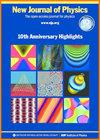Madelung mechanics and superoscillations
IF 2.8
2区 物理与天体物理
Q2 PHYSICS, MULTIDISCIPLINARY
引用次数: 0
Abstract
In single-particle Madelung mechanics, the single-particle quantum state is interpreted as comprising an entire conserved fluid of classical point particles, with local density and local momentum (where R and S are real). The Schrödinger equation gives rise to the continuity equation for the fluid, and the Hamilton–Jacobi equation for particles of the fluid, which includes an additional density-dependent quantum potential energy term , which is all that makes the fluid behavior nonclassical. In particular, the quantum potential can become negative and create a nonclassical boost in the kinetic energy. This boost is related to superoscillations in the wavefunction, where the local frequency of Ψ exceeds its global band limit. Berry showed that for states of definite energy E, the regions of superoscillation are exactly the regions where . For energy superposition states with band-limit , the situation is slightly more complicated, and the bound is no longer . However, the fluid model provides a definite local energy for each fluid particle which allows us to define a local band limit for superoscillation, and with this definition, all regions of superoscillation are again regions where for general superpositions. An alternative interpretation of these quantities involving a reduced quantum potential is reviewed and advanced, and a parallel discussion of superoscillation in this picture is given. Detailed examples are given which illustrate the role of the quantum potential and superoscillations in a range of scenarios.马德龙力学和超振荡
在单粒子马德龙力学中,单粒子量子态被解释为由经典点粒子组成的整个守恒流体,具有局部密度和局部动量(其中 R 和 S 为实数)。薛定谔方程产生了流体的连续性方程,以及流体粒子的汉密尔顿-贾可比方程,其中包括一个额外的与密度相关的量子势能项,这就是使流体行为非经典化的全部原因。特别是,量子势能可以变为负值,并产生非经典的动能提升。这种提升与波函数中的超振荡有关,在超振荡中,Ψ 的局部频率超过了其全局带限。贝里证明,对于能量 E 确定的态,超振荡区域正是......的区域。对于带限为Ⅴ的能量叠加态,情况略微复杂一些,约束不再是Ⅴ。然而,流体模型为每个流体粒子提供了一个确定的局部能量,这使得我们可以定义超振荡的局部带限,根据这一定义,所有超振荡区域都是一般叠加态的所在区域。我们回顾并提出了这些量的另一种解释,其中涉及量子势的降低,并对这种情况下的超振荡进行了平行讨论。还给出了详细的例子,说明量子势和超稳定在一系列情况下的作用。
本文章由计算机程序翻译,如有差异,请以英文原文为准。
求助全文
约1分钟内获得全文
求助全文
来源期刊

New Journal of Physics
物理-物理:综合
CiteScore
6.20
自引率
3.00%
发文量
504
审稿时长
3.1 months
期刊介绍:
New Journal of Physics publishes across the whole of physics, encompassing pure, applied, theoretical and experimental research, as well as interdisciplinary topics where physics forms the central theme. All content is permanently free to read and the journal is funded by an article publication charge.
 求助内容:
求助内容: 应助结果提醒方式:
应助结果提醒方式:


